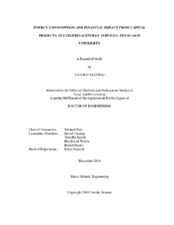| dc.contributor.advisor | Pate, Michael | |
| dc.creator | Sakurai, Yasuko | |
| dc.date.accessioned | 2017-03-02T16:44:47Z | |
| dc.date.available | 2017-03-02T16:44:47Z | |
| dc.date.created | 2016-12 | |
| dc.date.issued | 2016-09-14 | |
| dc.date.submitted | December 2016 | |
| dc.identifier.uri | https://hdl.handle.net/1969.1/158956 | |
| dc.description.abstract | This record of study presents the intern’s engineering and management experiences during her doctoral internship with Utilities & Energy Services (UES), Texas A&M University (TAMU) in partial fulfillment of the requirements for the Doctor of Engineering program. The intern was involved in the implementation of two capital projects, the chilled water system optimization project and the thermal energy storage tank project, during the internship period. Through this internship, the intern met her
technical internship objectives of enhancing her understanding of the chilled water system, the “Demand Flow” optimization software, and the thermal energy storage tank operation. The efficiency of the west campus chilled water system and its avoided consumption and cost during the commissioning period were reported. The intern also acquired additional managerial skills development at UES through skill development courses by TAMU Employee & Organizational Development, and in practice as a UES manager.
In addition to her involvement in project implementation, the intern was also interested in the energy consumption and financial impacts from implemented capital projects. These two projects were part of 2013 and 2014 UES capital projects, among a series of capital projects in the past ten years. Three system efficiency and financial indicators were introduced to benchmark the impacts from implemented capital projects starting in fiscal year (FY) 2004. Energy Utilization Index (EUI), EUI Ratio, and utility rates were the three indicators for benchmarking. The impacts of the two projects along with other capital projects were discussed through the projected results of the three indicators. The projected FY16 source and site EUIs were reduced mainly as a result of building consumption reduction efforts, while the projected EUI Ratio remained the same as previous year. The FY16 electricity and chilled water rates were decreasing because of lower purchased electricity rate and higher projected commodity consumptions. The chilled water rate reduction included the increase in debt and depreciation from chiller upgrades and other chilled water related capital projects. The FY16 heating hot water rate was increasing because of higher purchased natural gas rate. | en |
| dc.format.mimetype | application/pdf | |
| dc.language.iso | en | |
| dc.subject | Chilled Water System Optimization | en |
| dc.subject | Thermal Energy Storage Tank | en |
| dc.subject | Energy Utilization Index | en |
| dc.subject | Utility Rates | en |
| dc.title | Energy Consumption and Financial Impact from Capital Projects at Utilities & Energy Services, Texas A&M University | en |
| dc.type | Thesis | en |
| thesis.degree.department | College of Engineering | en |
| thesis.degree.discipline | Engineering | en |
| thesis.degree.grantor | Texas A & M University | en |
| thesis.degree.name | Doctor of Engineering | en |
| thesis.degree.level | Doctoral | en |
| dc.contributor.committeeMember | Claridge, David | |
| dc.contributor.committeeMember | Jacobs, Timothy | |
| dc.contributor.committeeMember | Welch, Ben David | |
| dc.contributor.committeeMember | Henry, Robert | |
| dc.type.material | text | en |
| dc.date.updated | 2017-03-02T16:44:47Z | |
| local.etdauthor.orcid | 0000-0003-0851-0315 | |


